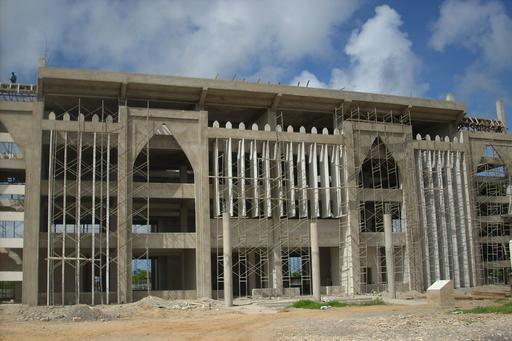
Controversial Corridor: Exploring changing human-environment and security dynamics along the LAPSSET development corridor in Kenya
Short description
This project studies the environmental, social and security dynamics at strategic sites along the proposed LAPSSET corridor (Lamu Port-South Sudan-Ethiopia).
Background
It is becoming increasingly difficult to understand contemporary dynamics on the African continent without taking into account the massive extension of large infrastructural systems, and the new conditions for circulation and connectivity that they inform. One of the most ambitious large-scale infrastructure projects to date is the LAPSSET development corridor, promising not only economic integration across the East African region but also the political integration of the marginalized North and Northeast part of Kenya into the nation-state. On the one hand, this project is presented as a powerful single narrative (“the LAPSSET corridor”) but, on the other hand, the corridor acquires a diverse set of meanings at different affected sites once disaggregated into competing claims, visions, expectations and contested materialization. In this project, we explore the relations between promise and fear of connectivity on the one hand and perceptions of citizenship and participation on the other. We will do so by mapping and studying specific controversies across sites that emerge in relation to issues of security and national resource access, use, and distribution.
Research aims
Embodying a multidisciplinary approach (the core researchers are situated within anthropology, environmental social sciences, and security studies), the project has the ambition to generate synergies and add knowledge on the politics of large development corridors. Through a mapping of key controversies around questions of natural resources and perceptions of security and insecurity a number of sites along the corridor (around Lamu, Garissa, Isiolo, Turkana), we will be able to, first, explore how and what kind of political ideas are conveyed via (proposed) infrastructure. Second, we will be able to contribute to the question of what expectations diverse communities have towards changes in the built environment. Third, we hope to contribute to the discussion of whether articulations of contestation along the corridor has the potential to generate new associations across scales for claiming greater participation in collective life.
Core themes
Connectivity & citizenship/participation
All parties affected attribute values to infrastructure. Unsurprisingly, these values differ between actors and occasions and are therefore subject to negotiation and change. Large infrastructures involve more than material assets. Infrastructures are socio-technical processes and relations that include physical objects, aspects of governance (such as expertise, regulations, institutions) as well as ideational & symbolic aspects. Infrastructures are furthermore future-oriented and come with the promises of connectivity and inclusion (increased mobility, access to public goods, social transformation, etc). At the same time, due to its massive intervention into the environment, the involvement of public authorities, its capital intensity as well as its potential for social transformation, large infrastructure systems also evoke concerns with regard to how the political economy of infrastructure interferes in everyday lives of communities. At the core of our exploration of security and resource controversies is an interest in exploring these different imaginaries attributed to the discourse and materialization of large infrastructure projects and ask how they affect participation, inclusion, and citizenship.
Natural resource access-, use- and distribution
We explore how rights to land are being discursively and materially reconfigured through the promise (and fear) of new forms of connectivity and circulation along the LAPSSET development corridor. The envisioned increased human mobility as well as the circulation of goods along the corridors network of roads, railways, and power supply will significantly transform local and regional economies through improved access to and distribution of resources. However, we acknowledge that the provision of better resource access for some may constrain access to resources for others. Infrastructure investments most concretely and directly affect access to- as well as use and distribution of land. First, if realized, roads, pipelines, airports, ports, and logistics hubs, along with the new facilities and activities that they enable, simply require a lot of land. Second, the mere existence of visions and plans of infrastructure investments, even if not realized in the end, changes the way land is perceived and valued by a variety of actors across scales. Third, access, use, and distribution of land tend to be closely related to other natural resources, for example, oil, water, wildlife, etc. In the project, we probe different examples of contestations related to land rights along the LAPSSET corridor, through a lend tenure lens primarily based on critical institutional theory. We pay particular attention to the question of how and to what extent local contestations around the land in the wake of LAPSSET are informed by different sets of institutional relations and arrangements.
Security
If realized, the corridor will traverse what both the British and successive Kenyan governments considered a frontier area: a non-pacified, not-yet-integrated region. The promise and realization of new forms of connectivity, circulation, and mobility through the LAPSSET development corridor has significant security implications in this area. On the one hand, LAPSSET comes with the promise of increased integration of previously marginalized areas into the Kenyan state, a promise towards more economic and physical security. On the other hand, if this corridor is to become a vital artery for East African economies, the corridor or the resources supposed to circulate, become the objects of security measures. Within this theme of the project, we explore security rationales and practices with regard to the LAPSSET corridor.
Research questions
- How do promises and fears of connectivity in relation to LAPSSET inform emerging controversies on security and natural resources at different sites along the corridor?
- How do emerging controversies on security and natural resources along the LAPSSET corridor relate to the political economy of citizenship and participation in Kenya?

Members
- Theodore Aalders
- Jan Bachmann
- Benard Musembi Kilaka
- Per Knutsson
- Hussein Mahmoud, Technical University of Mombasa in Kenya